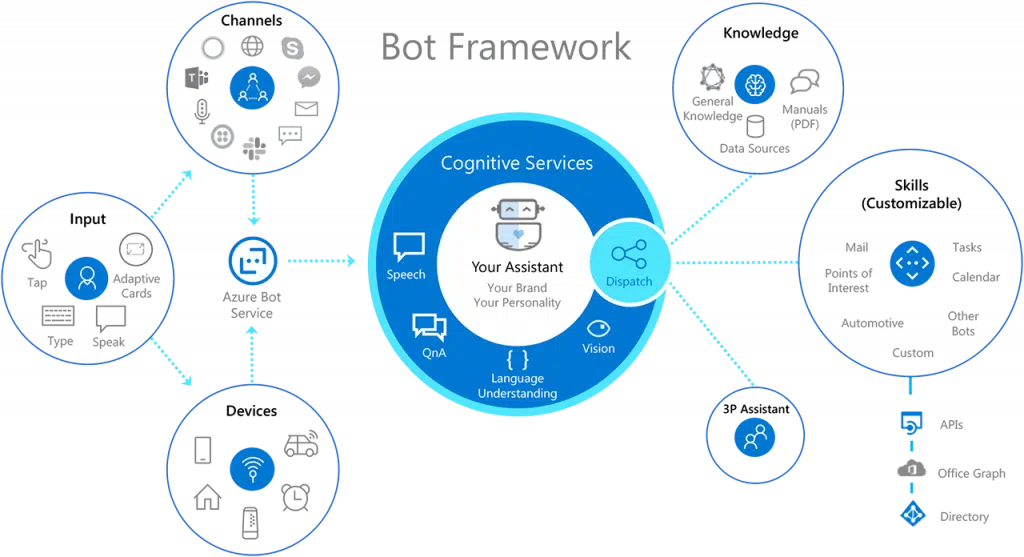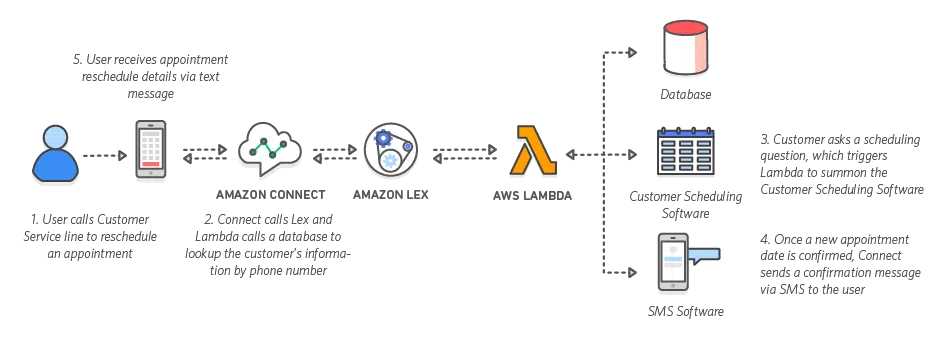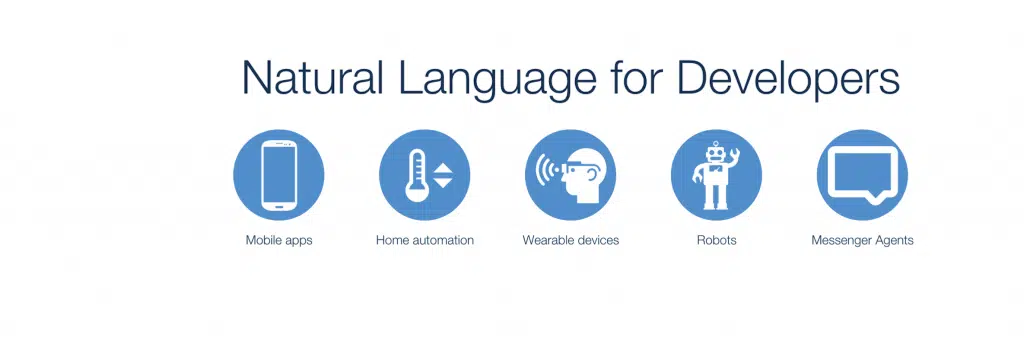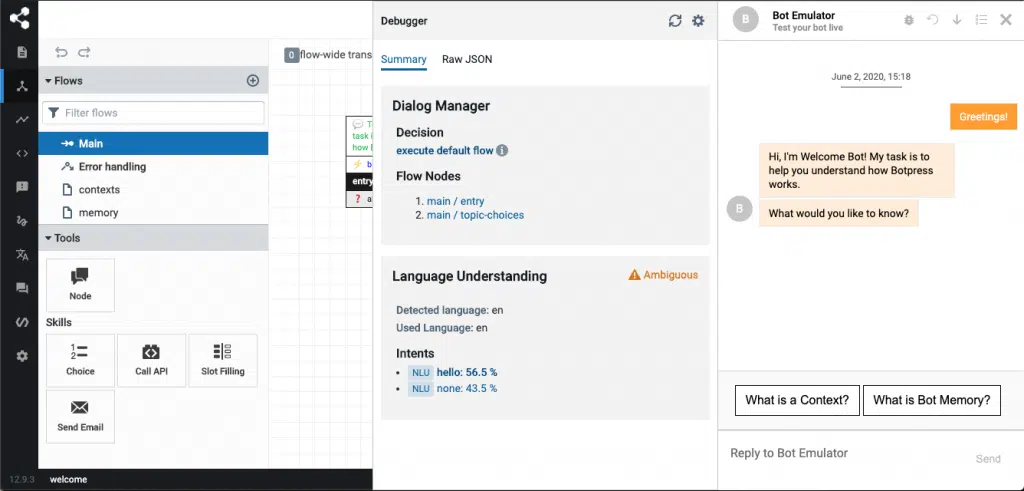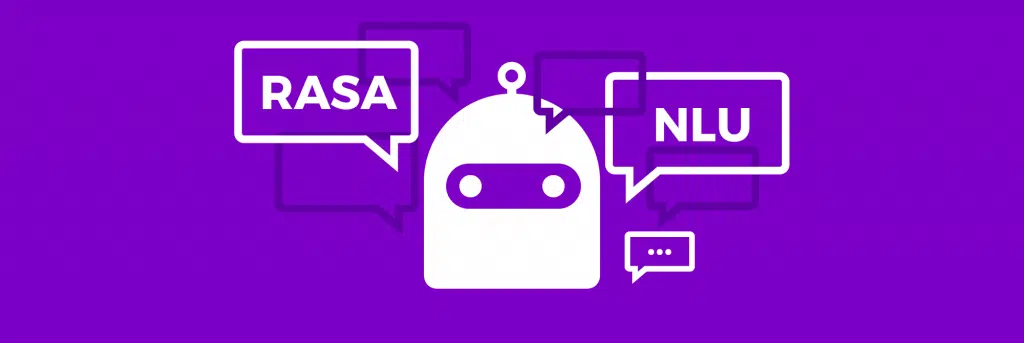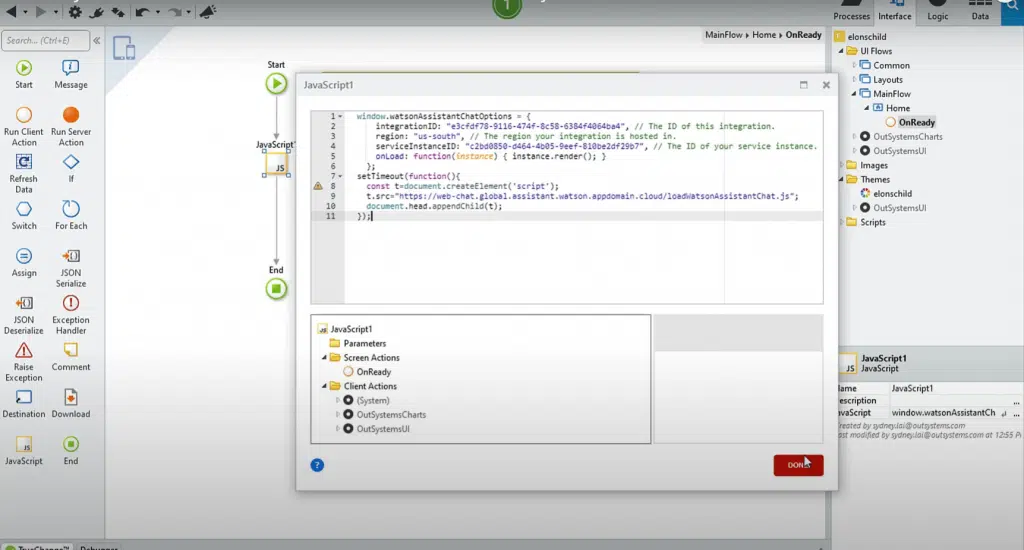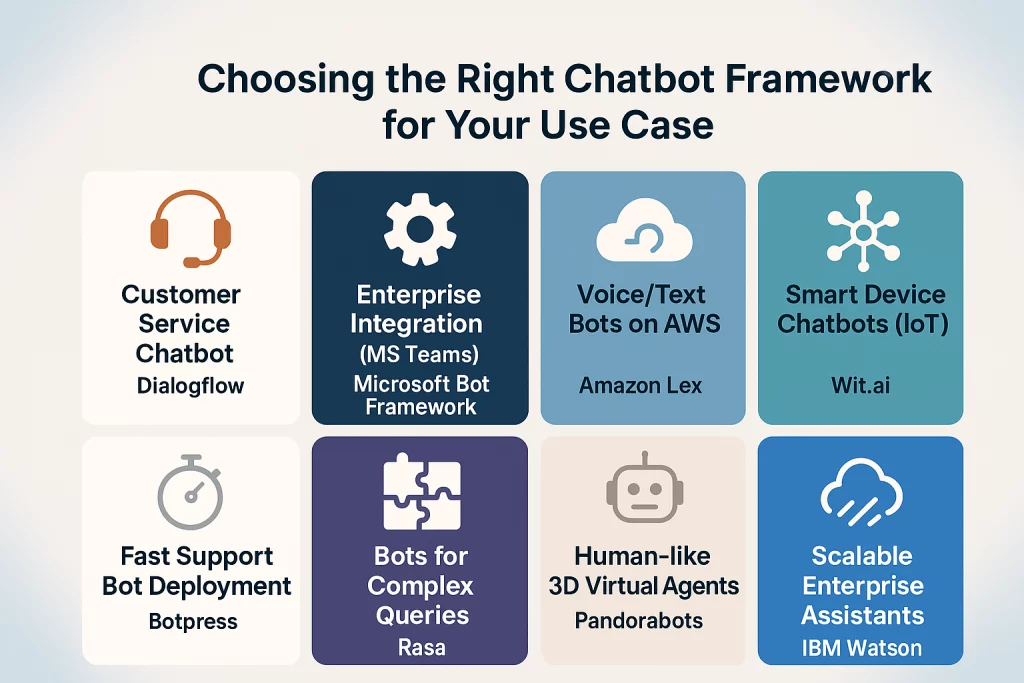Table of Contents
Chatbot development frameworks have been around for a while. Many successful businesses use them to develop some form of a chatbot to engage with their customers.
But do you really need to have your own chatbot developed?
The answer is a strong yes. Why? Chatbots are one of the most engaging marketing automation tools, and they can contribute tremendously to your overall marketing strategy. For instance, 67% of global customers have interacted with a chatbot at least once in the past year.
Okay, chatbots might be helpful, but they are also complex and expensive to develop, right? Wrong. In 2021, chatbot development services became more accessible than ever. The turnaround times for chatbot development improved, and many more developers entered the market.
But the real challenge in chatbot development is to pick the proper chatbot framework for your business and hiring a chatbot expert that can deliver.
To make things easier for you, we hand-picked the seven best chatbot development frameworks for any business occasion. Ready to pick the best chatbot framework for your company? Read on!
What Is a Chatbot Framework?
A chatbot framework is a developer-oriented toolkit that enables the creation of automated customer interaction systems by providing the underlying logic, integrations, and structure needed to interpret user input and generate appropriate responses.
Unlike platforms—which are commonly used by non-developers and have limited capabilities—chatbot frameworks are designed for developers and coders, providing the tools needed to build chatbots from the ground up.
These frameworks integrate seamlessly into existing tech stacks by connecting with APIs, databases, and third-party services, enabling custom workflows and real-time data exchange.
Chatbots 101: Understand the Basics Before You Make Your Pick
Before you pick the best framework for your business, let’s break down the essentials so you can make an informed decision.
What are the 4 Types of Chatbots?
There are four general types of chatbots:
- Menu-based chatbots: Menu-based or button-based chatbots present users with a predefined set of options, allowing them to navigate through a scripted menu to find the most relevant response. These chatbots have limited functionality but are great for tasks like answering questions and scheduling appointments.
- Simple, a.k.a. rule-based chatbots: These chatbots analyze customer queries based on the keywords entered and then provide automated responses based on the information previously uploaded in the chatbot database.
- AI-powered chatbots: AI-powered chatbots use machine learning (ML) and natural language processing (NLP) technologies to generate the best responses for customer queries automatically. These chatbots learn as they interact with more customers and require some advanced training in the early stages.
- Voice chatbots: Voice chatbots are AI-powered conversational tools that are capable of processing human speech, interpreting intent, and responding in real-time. By leveraging text-to-speech technology, they enhance accessibility and improve the customer experience.
Benefits of Using a Chatbot Framework
Using a chatbot framework offers greater customization, scalability, and seamless integration with existing systems, enabling developers to build more flexible and intelligent chatbot solutions.
Once developed, chatbots provide a variety of benefits for your business:
- 24/7 customer support availability
- Immediate response time
- High response rates (35-40%)
- Reduced customer support costs
- Huge time-saver
- Automated storage of customer data
- Integrated with the CRM of your choice
The 7 Steps to Building a Chatbot Strategy
Nothing about chatbot development is random. Every stage of your chatbot strategy is carefully planned and aligned with your goals, often with the guidance of a custom AI development company that understands both technology and business needs
- Define your chatbot’s purpose: Whether your company wants to reduce response times, increase personalization, or boost sales, the purpose of your chatbot should be clearly defined, as it will shape the rest of your strategy.
- Choose a chatbot type: As mentioned, different chatbot types have unique functionalities and serve different purposes. Before making a decision, carefully consider the features required for your project, your business size, and the unique needs of your target audience.
- Select the right chatbot framework: Depending on factors like your project goals and the complexity of your data, your partner will choose an AI chatbot framework that best fits your needs.
- Design user conversations: The next step is to create natural language interactions between users and the chatbot, which may include crafting dialogues, building flows, and shaping the chatbot’s personality to improve the user experience.
- Train the chatbot (AI/NLP if applicable): This step involves feeding the chatbot with relevant data, refining its understanding of user intent, and continuously improving its natural language processing capabilities to ensure accurate and context-aware responses.
- Integrate backend services (CRMs, APIs): Developers will then connect the chatbot to tools like CRM systems and APIs so it can access data, perform tasks, and provide real-time responses based on user input.
- Test, deploy, optimize: Your chatbot will then be tested for key factors like user intent and data security before deployment. After the initial launch, developers will continue to optimize the bot based on user feedback and interactions.
8+ Best Chatbot Development Solutions: Picking Your Winner
You can create chatbot solutions using a variety of chatbot frameworks. To create a proper chatbot, you will have to hire a certified developer, who is familiar with the coding languages used to develop the chatbot framework.
Depending on the chosen framework, you can deploy your chatbots directly into your third-party apps, messaging platforms, or even electronic devices.
Now, let’s look at the best chatbot development frameworks and see what makes them unique.
#1: Dialogflow
Dialogflow is a Google-owned natural language learning platform used to develop a variety of chatbot solutions. It’s a great fit for anyone looking for unmatched scalability, cross-platform capabilities, and both voice and text support.
You can integrate the chatbots created in Dialogflow into any significant social media network, and it would work seamlessly across all platforms and devices thanks to Google’s powerful API.
Use Cases: Chatbot development, voice interface integration, customer support automation, multi-platform deployment.
Ideal For: AI-powered chatbots.
Pricing: Dialogflow’s pricing structure is based on usage—charging per request and audio duration—with different rates for text, voice, and advanced features across its ES and CX editions. You can get more details here.
| PROS | CONS |
|---|---|
| Supports both voice & chat | Lackluster support |
| Versatile API (Supports Alexa, Google Assistant, Slack, Twitter, etc.) | Steep learning curve |
| Easily Scalable | |
| 20+ languages supported |
#2: Microsoft Bot Framework
Microsoft Bot Framework provides a user-friendly interface and comes preloaded with various bot templates to simplify the development process. It is a robust framework, making it a popular choice for developers knowledgeable in Node.js and C#.
On the downside, Microsoft Bot Framework does not have native NLP or voice recognition support. This makes it a bad fit for AI chatbot or voice assistant chatbot development. Moreover, it is not as easy to scale as the Google solution.
Use Cases: Chatbot development, enterprise system integration, customer service automation, virtual assistants for Microsoft Teams.
Ideal For: Enterprise-grade chatbots with complex integrations.
Pricing: Microsoft Bot Framework’s pricing is based on message volume, with standard channels being free and premium channels charging per 1,000 messages, plus additional costs for hosting and Azure services. Learn more here.
| PROS | CONS |
|---|---|
| Simpler to use | No native natural language processing support |
| Has 100+ pre-built chatbot templates | Limited to Node.js and C# |
| Visual flow builder | |
| Good support and tutorials |
#3: Amazon Lex
Lex is an Amazon-branded chatbot development framework that operates on AWS servers. It offers one of the simplest interfaces and is praised for the ease of use that it provides. Lex has unmatched conversational capabilities—it requires virtually no training time to process user input and provide automated responses.
Moreover, you can deploy Amazon Lex-enabled chatbots into any mobile application, messenger, or IoT device, making it the best bang-for-your-buck chatbot solution for beginners. Best of all, it comes with a powerful free version that has no development restrictions.
Lex offers one of the best chatbot management consoles and allows you to deploy your chatbot cross-platform with just one click.
Use Cases: Chatbot development, voice-enabled applications, enterprise productivity chatbots, customer support automation.
Ideal For: Voice and text chatbots that require seamless integration with AWS cloud services.
Pricing: Amazon Lex allows companies to process up to 10,000 text requests and 5,000 speech requests or speech intervals per month for free for the first year. After that, pricing is based on usage—$0.004 per speech request and $0.00075 per text request. Learn more here.
| PROS | CONS |
|---|---|
| One-click cross-platform deployment | Limited chatbot hosting options |
| Unmatched conversational AI capabilities | Chatbot goes down if AWS goes down |
| Easy to scale | Occasional bugs |
| SDK for Ios, Android Devices | |
| Supports all messengers |
#4: Wit.ai
Wit.ai was built to support Internet of Things (IoT) devices (smart homes, smartwatches, smart fridges, smart cars).
While wit.ai is quite complex, the platform API documentation is detailed and beginner-friendly. It has one of the strongest natural language processing engines, and best of all—it’s a completely free AI chatbot framework.
Use Cases: Voice assistants, devices, cars, and messengers that have to deal with lots of clients at once.
Ideal For: Programmers dealing with chatbots on electronic devices.
Pricing: Free, including for commercial use.
| PROS | CONS |
|---|---|
| Detailed API documentation + strong community support | NLP engine training takes a lot of time |
| Best for IoT | Hard to find missing parameters |
| Strongest NLP capabilities | |
| 130+ languages supported |
|
| Quick deployment on FB messenger |
#5: Botpress
Botpress is like WordPress but for bots:
- The platform is open-source and free
- You have countless developers creating plugins and integrations for it
- The community is thriving, and there’s tons of information online
- Templates for bots
Besides this, just as WordPress simplified web development, Botpress is also set to simplify chatbot creation.
While it might be one of the most rigorous chatbot frameworks, the documentation is highly detailed, and the communal support is strong, making it easy to get started.
Use Cases: Chatbot development, customer support automation, internal helpdesk bots, conversational AI for websites and apps.
Ideal For: Building customer support chatbots quickly and easily.
Pricing: Botpress offers a free pay-as-you-go option, with paid plans starting at $89 per month. Learn more about their pricing here.
| PROS | CONS |
|---|---|
| Highly-customizable | Steep learning curve |
| Native JavaScript support | It gets buggy as you add integrations |
| No-code environment for a bot manager | |
| Simple to learn |
#6: Rasa
When it comes to natural language processing, bots usually analyze user input and then look for the right answer in the pre-loaded database.
Rasa takes it a step further and allows you to create bots that behave like real humans in conversation, creating their own responses.
Rasa’s natural language understanding (NLU) algorithms simplify the process of training your chatbot and enable your chatbots to look for information on their own, without much training.
Use Cases: Real-time voice assistants, IT helpdesk bots, contact center automation, lead generation and sales assistants.
Ideal For: The development of support bots that require a deeper understanding of customer queries.
Pricing: Rasa is free for developers and teams starting an AI assistant project. You can also check out the available Growth and Enterprise subscription plans here.
| PROS | CONS |
|---|---|
| Personalized bot responses | Not suitable for beginners |
| Simple bot training | Knowledge of NLU/NLP required |
| Deploy on own servers (higher security of data) | Not all the info about possible bugs is available online. |
| Multiple development environments |
#7: Pandorabots
Pandorabots is the unicorn of all the chatbot development frameworks. It offers all the standard features of the high-quality chatbot development frameworks but also takes an innovative development approach.
Pandorabots uses a specifically developed AI markup language (AIML) to build AI-driven virtual agents that act like real humans, and with 3D modeling added on top, the results appear remarkably lifelike.
Use Cases: AI-driven virtual agents, customer support automation, educational bots, 3D avatar-based assistants.
Ideal For: Developing interactive chatbot models and business solutions.
Pricing: Pandorabots offers a free plan with limited capabilities, as well as additional paid tiers starting at $19 a month. You can view the plans here.
| PROS | CONS |
|---|---|
| Integration with all major messaging platforms | Not suitable for IoT |
| Integrate your bots into third-party apps | Pricey |
| API access | AIML Language used for development works only with Pandora |
#8: IBM Watson
IBM Watson is the most popular AI development framework used by some of the biggest companies for complex projects. It offers the highest standards of security and data storage.
Watson’s complex ML algorithms enable chatbots to interpret user queries and generate custom responses automatically. Chatbots developed on the IBM framework can be deployed into virtually any third-party application, messaging platform, or device.
Use Cases: Customer support automation, enterprise virtual assistants, conversational AI for apps, voice-enabled services.
Ideal For: Building AI-powered chatbots with advanced natural language understanding and enterprise-level scalability.
Pricing: IBM Watson Assistant offers a free Lite plan with limited usage, while paid plans start at $140 a month. You can check out the plans here.
| PROS | CONS |
|---|---|
| Most rigorous AI development platform | Tough to learn |
| Advanced ML engine | Lack of tutorials online |
| Customer data stored on a private cloud-only | Expensive |
| Automated interpretation of positive/negative responses |
Choosing the Right Framework for Your Use Case
With so many AI chatbot frameworks available, selecting the right one depends on your specific goals, technical needs, and deployment environment. Here’s a quick guide to help you choose the best fit:
AI Agent Frameworks: The Future of Scalable Bots
If there’s one thing we’re sure of, it’s that AI is the future of chatbot development.
As an increasing number of companies build AI agents, frameworks like Langchain and AutoGPT are becoming essential for orchestrating tasks, managing memory, and enabling agents to interact intelligently with external tools and environments. Working with experienced AI consulting companies can help businesses select and implement the right frameworks based on their scalability, security, and long term goals.
Open-source large language models (LLMs) such as Mistral and LLaMA 3 are also playing a critical role in this transformation—enabling developers to build powerful, private, and scalable agents without relying on proprietary APIs. This provides more control, customization, transparency, and innovation, all of which are critical for staying competitive in the business landscape.
Even traditional chatbot frameworks are adapting to this new wave. For instance, Rasa now supports LLM integration, allowing developers to combine the reliability of intent-based NLU with the flexibility and creativity of generative AI.
As the line between chatbots and autonomous agents continues to blur, we expect more frameworks to embrace multi-agent orchestration, tool use, and memory-enhanced conversations. For businesses looking to stay ahead of these advancements, Scopic’s custom AI agent development services help transform these emerging capabilities into real, scalable solutions.
Recap of Things to Keep in Mind…
As you can see, the world of chatbots is quite diverse. Every aspect of your strategy—from chatbot type to hosting, AI features, and AI integration solutions—plays a critical role in your success.
The final pick for your perfect chatbot development framework will depend on a few things. Here are a few questions that should help you make the right choice:
- Are you developing a customer service assistant, voice assistant, or a bot for smart devices?
- Which coding languages are your programmers proficient in?
- Do you want your chatbot to have AI capabilities?
- Should you choose an open-source solution or host the chatbot on your own servers?
By answering these questions, you can confidently narrow your options and choose the framework that best fits your needs.
At Scopic, we’re experts at creating custom solutions tailored to the unique needs of your business. Our team will take the time to evaluate your specific needs and choose the right chatbot framework for you.
Contact us to get a free quote on our AI chatbot development services.
FAQs about Chatbot Frameworks
What is the best chatbot framework for AI use?
The best AI chatbot framework depends on your goals, but Dialogflow, Rasa, and IBM Watson are top choices due to their advanced natural language understanding, scalability, and integration capabilities, especially when implemented with the support of AI integration consulting.
What is the difference between a chatbot and a chatbot framework?
A chatbot is the end-user application that interacts with people, while a chatbot framework is the set of tools and infrastructure used to build, deploy, and manage that chatbot.
Can chatbot frameworks integrate with GPT?
Yes, many chatbot frameworks can integrate with GPT models to enhance conversational abilities, enabling more natural, context-aware interactions through API-based integrations.
Which chatbot frameworks are open-source?
Popular open-source chatbot frameworks include Rasa, Botpress, and ChatterBot.

About Chatbot Frameworks Guide
This guide was authored by Maksim Lezginov and updated by Baily Ramsey.
Scopic provides quality and informative content, powered by our deep-rooted expertise in software development. Our team of content writers and experts have great knowledge in the latest software technologies, allowing them to break down even the most complex topics in the field. They also know how to tackle topics from a wide range of industries, capture their essence, and deliver valuable content across all digital platforms.




